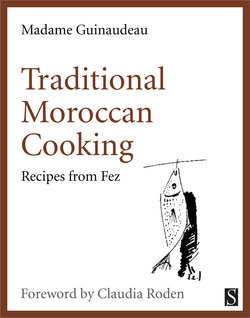Читать книгу Traditional Moroccan Cooking - Madame Guinaudeau - Страница 7
На сайте Литреса книга снята с продажи.
UTENSILS FOR COOKING AND SERVING
ОглавлениеI would like to make you see the glitter of the copper and brass pots, the colour of the baskets made from esparto grass and doum; praise the shape of the coarsely decorated brown and ochre pottery; have you feel the roughness of the wood, the artlessness of the earthenware, the simplicity and primitive austerity of the shapes and raw materials; and at same time show you the rich decoration of the English and Chinese porcelain, the painted and gilded cut glass from central Europe.
Boqrej: a kettle used for boiling water for tea.
Chkoua: a goatskin bottle used for carrying water.
Chtato: a small sieve, the bottom of which is made of linen or silk spun in Fez.
Gdra: the lower part of the pot for couscous in which the meat and vegetables are cooked, made of earthenware or copper.
Gdra del trid: a pot with a curved bottom, and a large paunch-like opening, which, when placed on the brazier, sends the heat to the inner sides and bottom of the pot, where the sheets of dough for trid are cooked.
Genbura: a glazed earthenware pot, very broad relative to its height, used for keeping water.
Ghorbal: a sieve, its bottom made of perforated leather, used for gauging the semolina.
Gsaa: a large, round unglazed baked clay dish made in Fez. The gsaa is made of oak, olive or walnut wood in certain districts, or from palms in the oases. Used for making bread and couscous and kneading pastry, the gsaa is also employed for washing.
Ied ettas: an often charmingly shaped ewer with a long slender spout in brass or embossed silver plate, used for pouring water over the fingers before and after a meal. When not in use it is placed on a pan called a tass.
Kanoun: a charcoal pan made of iron or copper, but more often of sun-baked clay.
Khabia: an earthenware jar, glazed inside, high and not very wide, found in different sizes and used for preserving meat and storing dried vegetables, flour and corn.
Kskas: that part of the pot, perforated at the bottom and inserted in the gdra, used for cooking the couscous grains.
Mghorfa: a large spoon carved out of a block of wood.
Mida: in Fez they call a round dish with an odd pointed hat in which cakes are served a mida, a wooden tray with a high rim and a conical lid is also called a mida, and finally the round table on which meals are served is the mida.
Midouna: A flat and flexible plaited basket woven from the fibres of esparto grass or doum.
Mqla: flat-bottomed copper pan with a straight edge and two handles.
Nafekh: an earthenware brazier.
Qa tagine: the deep copper dish in which the tagine slaoui is inserted and which serves to protect the table.
Qettara: an alembic used for distilling roses and orange-blossom.
Siniya: a tray made of embossed or plain copper, brass or silver plate. Those on which the utensils for making tea are placed have legs a few inches high.
Tagine slaoui: a round dish of glazed earthenware covered with a pointed lid which fits the dish exactly and can be used for cooking, keeping the dish hot or serving the tagine. Slaoui is used as a diminutive.
Tanjir: a large cooking pot.
Taoua: a basin designed to receive dirty water. These are made of copper or embossed silver plate and covered with a slab of the same metal in the middle of which the ewer is placed. It is over this basin that hands are washed before and after meals.
Tbiqa: a stiff round basket with a pointed lid made of esparto grass or doum decorated with coloured leather. Manufactured in or round about Marrakesh. Bread is placed in the tbiqa to protect it from the dust.
Tbla or mida: a round cedarwood dining-table, just over a foot high; the diameter varies according to the number of guests. Those made in Fez are plain or painted; those from Mogador are of inlaid woods encrusted with mother-of-pearl and much sought after.
Tboq: a sort of midouna made of finer basket-work.
Tila: a sieve made of rush or wire used for separating the bran from the crushed corn.
Tobsil dettiab: a large copper-plated tray with a small straight edge, used for glazing the bistilla.
Tobsil dial Iouarqa: a tray of the same sort, but it is the outside, which is copper-plated, on which sheets of pastry for bistilla are cooked.
With these utensils washing up is quickly done; the guests gone, the serving women will wash the earthenware dishes in the small pond in the middle of the patio, rubbing them with fine sand brought by some poor woman in a sack on her back from the local quarries and sold at the door for a few pence.
It is polishing them with that same sand, a lemon and a half-ripe tomato that will make the copper and brass in the kitchen glow with such power and brilliance.
